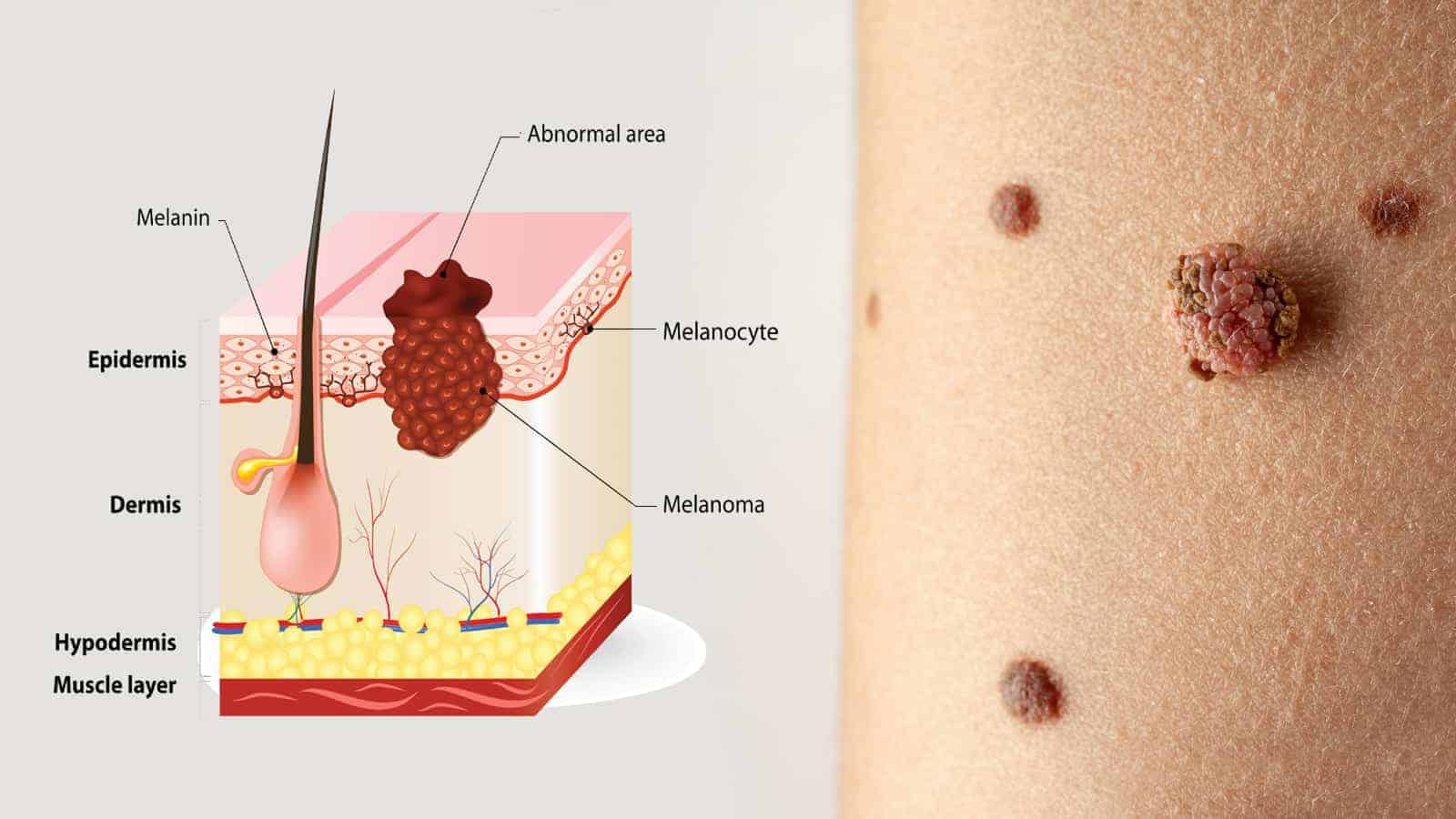Melanoma or skin cancer is often overlooked because people don’t feel it’s as severe as the other varieties. Sadly, skin cancer can be as small as a pimple that won’t disappear or a mole that starts growing beyond its boundaries.
People spend more time outside in nature during the spring and summer months. The risk of skin cancer increases when you’re out in the sun for long periods. Dermatological researchers found that one in five people will develop melanoma by the time they reach 70 years of age.
It’s an alarming statistic to realize that the chance of you developing this type of cancer is real. However, it should push you to be proactive. Thankfully, it’s one of the most preventable and curable forms of malignancy. The key is catching melanoma early to get the treatment you need.
Most people are looking for discoloration spots on their bodies that look oddly shaped, but there are other signs you can’t ignore. Here is a list of the most common melanoma symptoms many overlook.
12 Common Symptoms of Melanoma
If you see any irregularities in your moles, schedule a trip to the dermatologist immediately. Early detection saves many lives each year.
1. Your Genetics
 Your family tree is one of the most significant reasons you might develop melanoma. Familiar malignancy is a cancer that is typically found in families. If your mother, father, or siblings had such a case, it’s considered first-degree relative transference.
Your family tree is one of the most significant reasons you might develop melanoma. Familiar malignancy is a cancer that is typically found in families. If your mother, father, or siblings had such a case, it’s considered first-degree relative transference.
The chances of developing cancer increase by 50 percent when closely related. When your family has a history, you should be even more proactive about self-checks and note anything with irregular borders. Remember, if caught early, you can easily treat skin cancer.
2. A Blemish that Won’t Go Away
As you age, you get skin-colored bumps that may come and go. However, if you have a pink pimple that doesn’t seem to leave, it’s a cause for concern. A dermatologist must evaluate any spot that sticks around for more than a few weeks.
3. Skin Growths That Aren’t Brown or Black
There is a common misconception among people that skin growths must be brown or black to be cancerous. The most concerning are those that mask themselves as a blemish. Any skin growth that is pink or white can be just as dangerous, if not more.
A pimple should clear up in a few weeks and not return. If you have flesh-colored marks that hang around for longer than usual, then have them evaluated.
4. A Dark Band in the Fingernail
Sometimes, skin cancer develops as a vertical line across a toe or fingernail. The first thought is that you’ve banged your foot or hand. However, it’s a concern if the band is brown or black and has varied discoloration.
Another consideration is that the band is more extensive than three millimeters. While the line can be from an injury, it can also be a melanoma. Only an expert evaluation can determine if it’s benign or malignant.
5. You’ve Had Elective Radiation Treatment
Have you had an elective procedure using ultraviolet radiation to help with dermatitis or psoriasis? A study found that people have a higher risk of up to 15 years after their treatment of developing skin cancer.
A person with at least 150 treatments is at risk, but those with more than 250 have the highest risk factors. If you’ve had any of these procedures, then make sure to do your self-checks every month.
6. Your Immunity is Weakened
Having a compromised immune system makes you more susceptible to all types of acne, especially skin varieties. Those with a weak immune system include people who have been diagnosed with AIDS or are HIV positive and those who have cancer or are taking chemotherapy.
Also, anyone taking immunosuppressant drugs has an inflated risk of developing melanoma. There is also some risk among auto-immune conditions, though it’s not as great as those with diseases like AIDS.
 7. Shaving Nicks that Won’t Stop Bleeding
7. Shaving Nicks that Won’t Stop Bleeding
It’s normal to bleed a bit after shaving; however, it will bleed if you have a carcinoma on your skin. A razor can nick the skin’s surface, but these bumps can also spontaneously bleed.
If one spot seems to bleed frequently during a shave, it needs to be evaluated by a dermatologist. Try to avoid shaving around any area in question until it’s assessed.
8. You’ve Had HPV Virus
The human papillomavirus infects the anus and genital area. It also increases the chances of developing cervical cancer. Most people don’t understand that there are more than 100 different viruses in this family, and one of the viruses causes warts.
Just because you have a wart doesn’t mean you have HPV, but it does put you at a higher risk of developing skin cancer. The type of cancer would be the nonmelanoma type.
9. A Discolored Mole with Irregular Borders
Moles come in all shapes and sizes, but the color and borders are what you want to keep an eye on. An oddly shaped mole with irregular edges could be a sign of trouble.
If you have many moles, you can easily spot one, unlike the other. Most moles are benign, but you can’t take a chance if one seems distinct and has unique characteristics.
10. You’ve Had Squamous Cell Carcinoma Before
Once you’ve been diagnosed with squamous cell carcinoma, it doesn’t mean you can relax and not think about skin cancer. These growths are typically found on the cheeks, ears, nose, and lips. Even your old scars must be evaluated occasionally as cancer can return to that area.
11. You Work Around Dangerous Chemicals
In 2014, a dermatologic animal study was conducted that found that people who work around dangerous chemicals have a higher risk of developing melanoma. The people most at risk are those who work in an iron or steel foundry. Other substances that are concerning include:
- Arsenic
- Creosote
- Chimney Soot
- Shale Oil
- Asphalt
- Tar
- Diesel Engine Exhaust Fumes
12. You Have the Xeroderma Pigmentosum XPO Gene
The XP gene is hereditary and occurs in one out of a million people in this country. Though rare, those with this condition have a severe sensitivity to the sun. Any damaged cell caused by the ultraviolet rays cannot be repaired, making the risk of developing skin cancer more likely.
Become Vigilant, Perform Regular Self-Checks
It would help if you had a local dermatologist that you work with should anything suspicious arise. Additionally, they will recommend you self-check about once a month. It would help if you noted any abnormalities and moles that have discoloration, irregular borders, or are oddly shaped.
Just because you might not think it’s a big deal doesn’t mean that it shouldn’t be evaluated. Any significant changes in spots that look like blemishes or moles should be considered concerning until evaluated. An acronym to help you decide if you need help is ABCDE. Here is what these letters mean as you examine spots:
A – Asymmetry
Is the pimple or lump irregular-looking in color or shape?
B- Border
Look at the edges of the mole or pimple. Does it have jagged edges?
C- Color
Is the color consistent, or are there many color variations within the lump? Color variations are a big problem that needs to be addressed. However, that doesn’t mean that a consistent node in color isn’t a danger.
D- Diameter
No mole should be more significant than the end of a pencil eraser. It should be a red flag when a mole keeps growing or changes shape or color.
E- Evolving
A mole or blemish that starts constantly bleeding, changes in appearance, or becomes larger is always a concern. A dermatologist should evaluate one that keeps bleeding when you shave or becomes sore and bleeds for no reason.
 Final Thoughts on Catching the First Signs of Melanoma–and Seeking Early Treatment
Final Thoughts on Catching the First Signs of Melanoma–and Seeking Early Treatment
Even if you have any of these problems and need to be checked, skin cancer in its infancy is almost always curable. It’s the most common type of cancer in the United States and dermatologists can often treat them successfully.
The real problem comes into play when you let things go, and the lump’s changes are undeniable. Cancer can eat more profoundly into the skin, destroying tissue and good cells within the body. People can and do die from skin cancer; most of the time, it could have been completely treated.
Please don’t wait until it’s too late. It’s better to err on the side of caution than wake up and have something you could have prevented destroying your body. Remember, anything with irregular borders could be melanoma and needs an expert assessment.
Editorial Note 8.25.2023: Edited study to note that it was on animals, not humans

















